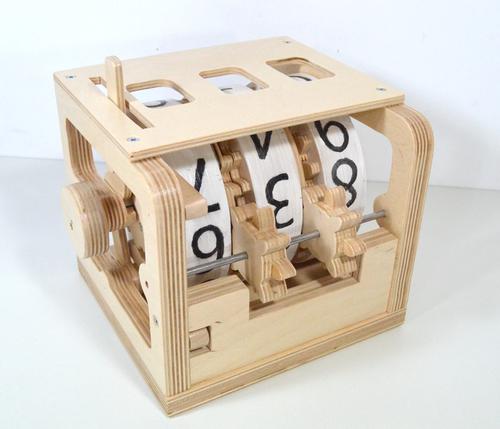Watching [Matthias Wandel] fabricate this mechanical counter from scrap wood is just fascinating. He likens the mechanism to the counters you would find on decades-old cassette tape players.
You may recognize the quality of [Matthias’] work. We’ve seen several pieces, but his binary adder is still one of our favorites. This project gives us a very clear view of the development and fabrication process. He even posted a detailed guide if you want to build your own.
He started by prototyping a mechanism to increment and decrement the counter. With that proven design he started laying out the rest of the gears. These were cut from plywood scraps he had from other projects. Notice the small gears seen above which are missing parts of some teeth. Those sections were removed using a drill press with a Forstner bit. The missing teeth cause the next digit over to increment more slowly, resulting in a 1/10 ratio. This part of the design is demonstrated about three minutes into the video after the break.















The gears that have some teeth cut down aren’t a 1:10 reducer but a 1:2 reducer. From what I remember it’s because the wheel that causes the 1:10 reduction has two teeth on it but you only want to flip the 10s counter once when it completes its revolution.
I love it! – I would like to see him do a digital clock with this type of setup.
It breaks my head trying to apply this mechanism to time instead of straight counts.
Minutes should be straightforward, just gotta tweak the gear ratios to make the ten minute have only 6 steps instead of 10.
I have no idea how I would do hours though. The easiest thing I can think of is have a two gears linked together 1:1 (or one double wide) and just have 12 (or 24) steps around. It just sucks that the tens hour gear needs to carry at different points at different times.
Alternatively, you could redefine the day to have 10- 100 minute hours, and his design is a great clock. You just need some mechanism to increment it every 86.4 seconds or so.
For hours you do need a 12-position wheel, yes. You could either number it 1-12, or number it 1,2,3,4,5,6,7,8,9,0,1,2 and put “carry” triggers after 9 and the second 2. Probably simplest just to make a single 1-12 indicator.
(Note that if you use the two-wheel setup, you also need to keep track of the fact that it’s 1-12, not 0-11! There are only 9 hours, not 10, that are prefixed with “0”.)
R-E-S-P-E-C-T!
Extremely methodic and well made video, bravo. I like the part where the parts are enormous to really understand what’s going on in the small mechanical counters.
Next do a 3D printed mechanical counter!
Already up on thingiverse:
http://www.thingiverse.com/thing:16068
Go Matthias, always great projects!
This is the guy that got me into (the admittedly limited amount of) woodworking I’m doing today. All of his projects impress the hell out of me :)
It’s a strange feeling when I look at engineering art like this. It’s not envy. It’s sort of sadness that I don’t have that same ability.
Work at it! You are capable of it. I believe in you. You can appreciate it, all you need is a drive to make it and you’ll get it made.
…and access to really cheap (comparatively) high quality plywood… sigh…
There are other materials to work with. Use soda cans if necessary. The point is: create! Build up a creative flow that you can use on new materials when they are available.
Awesome skills. Hat is off.
—————————————
Hi there,
Way cool, my friend John would love that !
Warmest regards.
This was very enjoyable to watch! I Simply love it.
in the end it all comes down to having a laser printer
Very nice video and build. nice way to start the day.
I knew exactly who made this as soon as I saw the picture. Matthias is an awesome guy; everyone should check out his site to see all the awesome things he’s made.
Brilliant. Reminds me of Jaimie Mantzel from the gigant robot project… but for parents to get their children to play with gears and mechanics…not easy. “How Mechanics Work” is one way to put it. The “book” is half book, half construction kit! take a look: http://constructingkids.wordpress.com/2012/11/05/book-review-how-machines-work-build-your-own-working-models/
@18:37: 999, 0, 1, 2, 7, 8, 9, 10, 11.. wait, what?
You missed the fade.